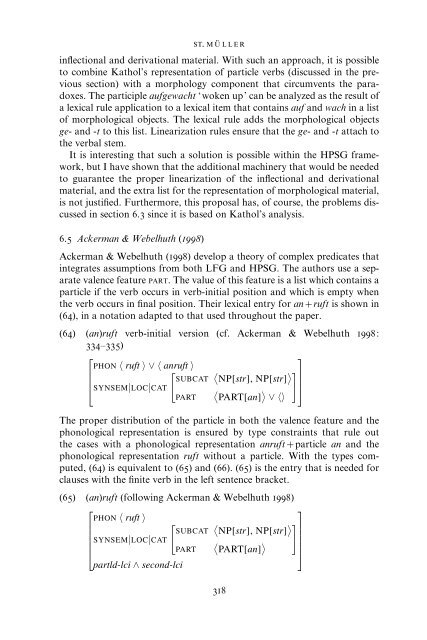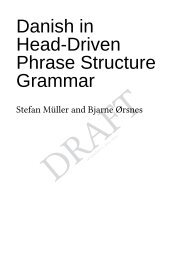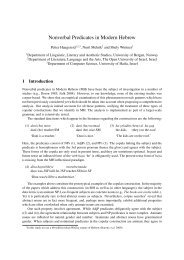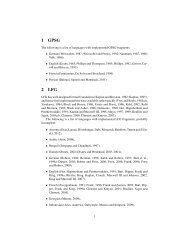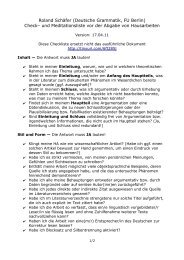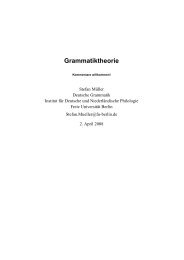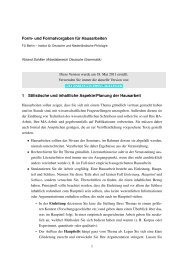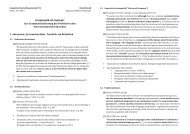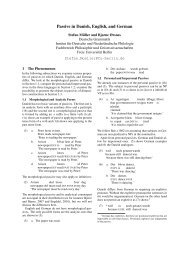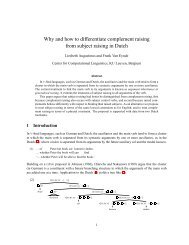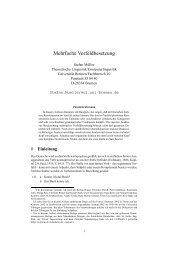Solving the bracketing paradox - German Grammar Group FU Berlin
Solving the bracketing paradox - German Grammar Group FU Berlin
Solving the bracketing paradox - German Grammar Group FU Berlin
You also want an ePaper? Increase the reach of your titles
YUMPU automatically turns print PDFs into web optimized ePapers that Google loves.
ST. MÜLLER<br />
inflectional and derivational material. With such an approach, it is possible<br />
to combine Kathol’s representation of particle verbs (discussed in <strong>the</strong> previous<br />
section) with a morphology component that circumvents <strong>the</strong> <strong>paradox</strong>es.<br />
The participle aufgewacht ‘woken up’ can be analyzed as <strong>the</strong> result of<br />
a lexical rule application to a lexical item that contains auf and wach in a list<br />
of morphological objects. The lexical rule adds <strong>the</strong> morphological objects<br />
ge- and -t to this list. Linearization rules ensure that <strong>the</strong> ge- and -t attach to<br />
<strong>the</strong> verbal stem.<br />
It is interesting that such a solution is possible within <strong>the</strong> HPSG framework,<br />
but I have shown that <strong>the</strong> additional machinery that would be needed<br />
to guarantee <strong>the</strong> proper linearization of <strong>the</strong> inflectional and derivational<br />
material, and <strong>the</strong> extra list for <strong>the</strong> representation of morphological material,<br />
is not justified. Fur<strong>the</strong>rmore, this proposal has, of course, <strong>the</strong> problems discussed<br />
in section 6.3 since it is based on Kathol’s analysis.<br />
6.5 Ackerman & Webelhuth (1998)<br />
Ackerman & Webelhuth (1998) develop a <strong>the</strong>ory of complex predicates that<br />
integrates assumptions from both LFG and HPSG. The authors use a separate<br />
valence feature PART. The value of this feature is a list which contains a<br />
particle if <strong>the</strong> verb occurs in verb-initial position and which is empty when<br />
<strong>the</strong> verb occurs in final position. Their lexical entry for an+ruft is shown in<br />
(64), in a notation adapted to that used throughout <strong>the</strong> paper.<br />
(64) (an)ruft verb-initial version (cf. Ackerman & Webelhuth 1998:<br />
334–335)<br />
⎡<br />
⎤<br />
PHON 〈 ruft 〉∨〈anruft 〉<br />
[ 〈 〉]<br />
⎢<br />
SUBCAT NP[str], NP[str] ⎥<br />
⎣SYNSEM|LOC|CAT<br />
〈 〉 ⎦<br />
PART PART[an] ∨〈〉<br />
The proper distribution of <strong>the</strong> particle in both <strong>the</strong> valence feature and <strong>the</strong><br />
phonological representation is ensured by type constraints that rule out<br />
<strong>the</strong> cases with a phonological representation anruft+particle an and <strong>the</strong><br />
phonological representation ruft without a particle. With <strong>the</strong> types computed,<br />
(64) is equivalent to (65) and (66). (65) is <strong>the</strong> entry that is needed for<br />
clauses with <strong>the</strong> finite verb in <strong>the</strong> left sentence bracket.<br />
(65) (an)ruft (following Ackerman & Webelhuth 1998)<br />
⎡<br />
⎤<br />
PHON 〈 ruft 〉<br />
[ 〈 〉]<br />
SUBCAT NP[str], NP[str] SYNSEM|LOC|CAT<br />
⎢<br />
〈 〉<br />
⎣<br />
PART PART[an]<br />
⎥<br />
⎦<br />
partld-lci ∧ second-lci<br />
318


